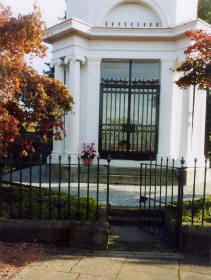Robert Burns is buried in St. Michael's Churchyard, Dumfries, Scotland.

Robert Burns' Mausoleum
see more photos Burns died of rheumatic fever in Dumfries on 21 July 1796.
He was originally buried in the north east corner of St. Michael's church yard, but
in September 1815 his body was transferred to the mausoleum which was erected in the
south-east corner of the churchyard and paid for by public subscriptions. (Even the
Prince Regent - later George IV made a contribution.)
Burns' wife's remains were added to the mausoleum in 1834 - at
which time a cast was taken of Burns' skull.
In 1778 Burns finally married Jean Armour and settled on a farm
at Ellisland near Dumfries. The following year he secured a job as an Excise Officer
and subsequently was able to retire from farming. |







